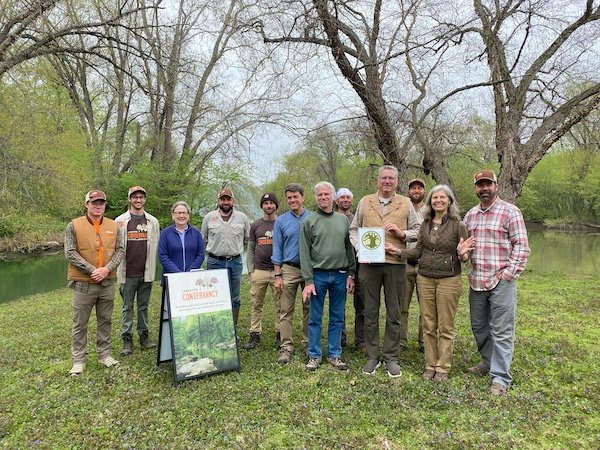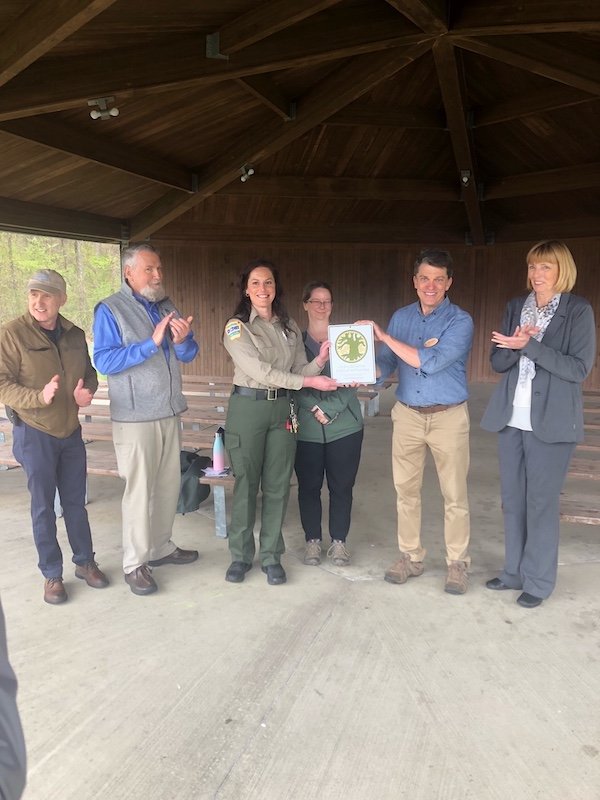The Best Kind of Rivalry
Pennsylvania vs. Ohio…which state now has the most dedicated forests?
Spring has been busy for the Old-Growth Forest Network as the forest dedications have been rolling in left and right. Our spring season kicked off back in Ohio with two spectacular back-to-back dedications. Executive Director Joan Maloof spent a busy week in Ohio, touring the state, giving talks, and most importantly, dedicating forests. With these two dedications in the books, Ohio was now tied with Pennsylvania for the most Network Forests at 20 in total. But within a matter of weeks, Pennsylvania pulled ahead again with their own twin dedications and is once again the state with the most Network Forests. Congratulations Pennsylvania for having a whopping 22 forests! Not only is it great to have a bit of neighborly rivalry, but it also means that both states have protected thousands of acres worth of old-growth and mature forests. Generations to come will be able to enjoy the wonders of these forests, all thanks to the hard-working community of forest protectors. Keep reading for more information about these newly added OH and PA forests.
Sigrist Woods at The Wilderness Center- Stark County, OH
Nestled in between Fox Creek and the Middle Fork of Sugar Creek, Sigrist Woods is a verdant, 21-acre haven of old-growth and mature tree specimens. Protected as a State Natural Landmark since 1983, many of the trees found within the Woods are well over 175 years old and primarily include white oak, burr oak, and sugar maple varieties. The forest has an easy, .5-mile trail that loops through the heart of the old-growth stand and lush wetlands fed by a small creek. Open year-round, visitors can see how the different seasons impact and change the forest. The Wilderness Center has been a foundational conservation organization in northeast Ohio since 1964 and has been pivotal to Wilmot ever since. The Center provides the community with education about the natural world, the importance of conservation, and much more.
Walter A Tucker Nature Preserve at Blacklick Woods Metro Park- Fairfield County, OH
Located less than 15 miles outside of downtown Columbus, Blacklick Woods Metro Park is a vast, 643-acre park that contains one of the most pristine remaining beech-maple forests left in Central Ohio. Managed by the Metro Parks Department, this forest is a great example of how municipalities and state-wide programs can play an active role in conservation-based management practices. As a part of Ohio’s State Nature Preserve program, the Walter A. Tucker Nature Preserve is protected against logging so that future generations to come can enjoy the beauty of nature, especially when they can be found juxtaposed within a larger metropolitan area. The entire park contains several different ecological zones, from a large prairie section to buttonbush swamps and densely forested areas with a wide variety of species. These forested areas support a wide array of species, including but not limited to white and pin oak, white ash with specimens of red maple, red elm, hophornbeam, American hornbeam, and dogwood, as well as both shagbark and bitternut hickory.
Otter Creek Nature Preserve- York County, Pennsylvania
Otter Creek Nature Preserve is located a little over 20 miles southeast of York, PA, right next to the mighty Susquehanna River. The preserve is a little under 300 acres of rocky and steep terrain, which has meant that the forest has had little to no commercial logging presence. The forest is made up of mature hemlock and mixed-hardwoods, but also contains remnants of American chestnut trees. The American chestnut was once prolific in Pennsylvania and other parts of the eastern United States, but sadly, this species was all but wiped out in the early 1900s by the chestnut blight- a highly infectious disease caused by a bark fungus from the Japanese chestnut tree. Of the estimated three billion chestnut trees that thrived in an enormous range, from Maine to Mississippi and from the Appalachian Mountains to the Atlantic coast, very few remain today. The Preserve was acquired by the Lancaster Conservancy organization as a part of the nationally recognized landscape conservation project and is minimally managed, with passive recreation being the most common reason for visiting. Though the trails are steep and can be strenuous at points, Otter Creek Nature Preserve is well worth it, especially to glimpse the living legend that is the American chestnut.
Boyd Big Tree Conservation Area- Dauphin County, Pennsylvania
The Boyd Big Tree Conservation Area is roughly 1,025 acres of stunning natural beauty which spans Blue Mountain. The old-growth section of the forest is around 75-100 acres and is located along the Creek Trail and meanders along the western boundary of the conservation area. Age estimates place some of the older specimens to have sprouted around 1900. Some of the acreage is situated on steep terrain and around rocky ravines which has the added benefit of making the area unsuitable for logging. Boyd Big Tree is managed by the Pennsylvania Department of Conservation and Natural Resources (DCNR) and as a recognized conservation area, this forest will not be logged or heavily managed according to the restrictive covenant that was included when the property was donated to the department in 1999. Alexander Boyd previously owned the property but was persuaded by his friend and nearby landowner, Joseph Ibberson, who had already donated some of his property to the DCNR. The American chestnut also has a connection at Boyd Big Tree Conservation Area as it does at Otter Creek. The American Chestnut Foundation was granted a small parcel of land, near the parking lot, to plant an experimental orchard of disease resistant trees. The Foundation’s mission is to help return the American chestnut to its historic native range by researching breeding, biotechnology, and biocontrol to produce a new variant that will be blight and disease-resistant. Boyd Big Tree Conservation Area is a great example of how a wide variety of stakeholders, including DCNR, Pennsylvania State Parks, The American Chestnut Foundation, and The Old-Growth Forest Network, can come together to protect and support such a priceless natural wonder.
Be sure to stay tuned to see if Ohio can pull ahead, or if Pennsylvania will continue to widen its lead. The summer is just starting, and dedication season is upon us!
Is there a forest in your area that should be included in the Old-Growth Forest Network? Fill out this simple nomination form today, or sign-up to become a County Coordinator if you haven’t already!





